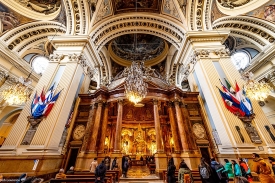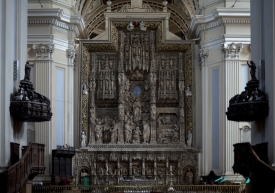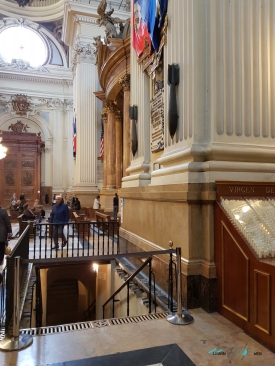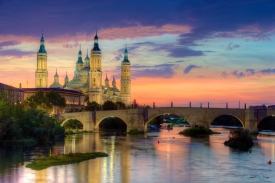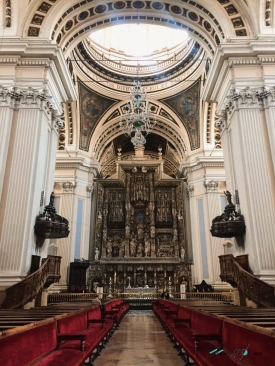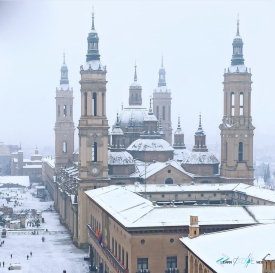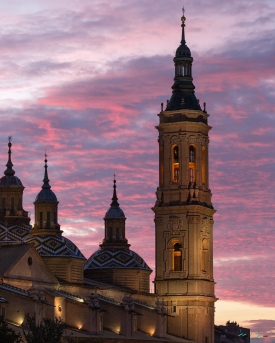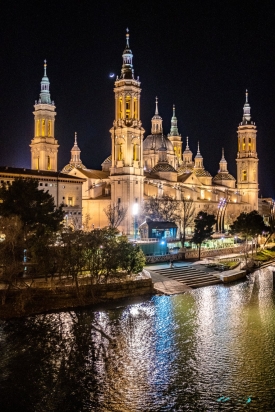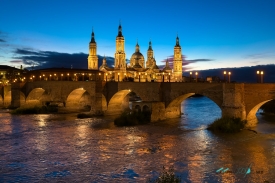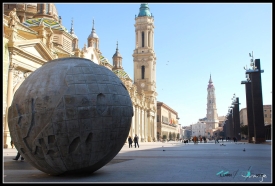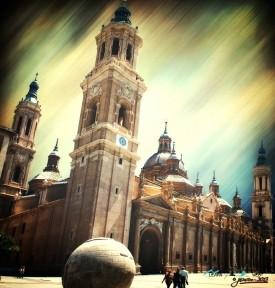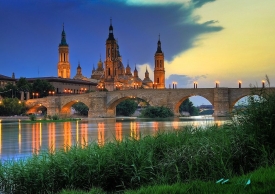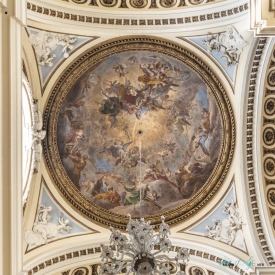The Cathedral-Basilica of Our Lady of the Pillar, is a Roman Catholic church in Zaragoza, Aragon, Spain. It is the largest baroque church and one of the most important in Spain and has the rank of cathedral of the Archdiocese of Zaragoza. Its name goes back to a tradition according to which the Virgin Mary, the mother of Jesus, appeared to the Apostle Santiago el Mayor, who was preaching on the banks of the Ebro. The virgin leaned on a column or pillar, around which the first Christian Marian temple was built.
Numerous churches have been built around the column one after another. The first was a small chapel to keep the pillar. Following the Reconquest of Zaragoza under King Alfonso I in 1118, a Romanesque church was built, which was damaged by fire in 1434. The church was rebuilt in the Gothic style with Mudejar elements. The current baroque building is due to extensions and reforms carried out between 1681 and 1754 according to plans by the architect Francisco de Herrera, el Mozo, appointed by a commission chaired by Juan JosĂŠ de Austria, then Viceroy of AragĂłn. In its current form, the building is 130m long, 67m wide and has eleven domes.
The rectangular building with four corner towers appears symmetrical from the outside, the interior is divided into a nave with three domes and two aisles, each with four domes. A clear orientation in the longitudinal direction only results from the Holy Chapel and the main altar and choir taken from the previous building.
The Holy Chapel forms a semi-open space within the eastern part of the basilica, which was added to the new building in 1725 by Ventura RodrĂguez. He chose an oval dome shape, which is open at the top and is complemented by half domes on the sides. Since the construction is supported by four main pillars of the basilica, the walls are replaced by columns and it can be accessed from three sides, the altar forming the wall towards the interior of the church. In its center is a white marble and gilt bronze sculpture depicting the arrival of the Virgin Mary, on the left a group of seven people who, according to legend, were converted by Saint James the Greater before Mary appeared on a column to hold it up. . This pillar is located on the right side of the chapel, but is also accessible to worshipers from the rear of the chapel. Above it stands a small statuette of the Virgin Mary made of gilded wood, which is surrounded by rich ornaments.
An element of the vaulted ceiling in the eastern part of the nave, facing the Holy Chapel, was decorated in 1772 by Francisco de Goya with the fresco The Adoration of the Name of God. This is Goya's first commission in Zaragoza after his return from Italy. He subsequently decorated the dome of the north aisle, the Regina Martirum (Queen of Martyrs), with another fresco. Two sketches of the work are exhibited in a showcase.
In addition to several Zaragoza bishops and archbishops, Saint Braulio also rests in the church, and General JosĂŠ Rebolledo de Palafox y Melzi, defender of Zaragoza during the Napoleonic wars.
A curiosity inside the Basilica del Pilar are two aerial bombs exposed near the Holy Chapel. During the Spanish Civil War, on the morning of August 3, 1936, a republican plane bombed the basilica. He dropped three bombs, none of which exploded. A bomb fell a few meters in front of the basilica, another went through the roof and the last one fell near the Francisco de Goya mural. Believers credited the protection of the Virgin Mary with preventing the bombs from exploding.
The Pilar basilica has a viewpoint, in the Pilar tower, from which you can admire the entire city of Zaragoza. A glass elevator lifts visitors, in twenty seconds, to a height of 62 meters, contemplating a spectacular panoramic view of the Ebro River and the historic center.
Numerous churches have been built around the column one after another. The first was a small chapel to keep the pillar. Following the Reconquest of Zaragoza under King Alfonso I in 1118, a Romanesque church was built, which was damaged by fire in 1434. The church was rebuilt in the Gothic style with Mudejar elements. The current baroque building is due to extensions and reforms carried out between 1681 and 1754 according to plans by the architect Francisco de Herrera, el Mozo, appointed by a commission chaired by Juan JosĂŠ de Austria, then Viceroy of AragĂłn. In its current form, the building is 130m long, 67m wide and has eleven domes.
The rectangular building with four corner towers appears symmetrical from the outside, the interior is divided into a nave with three domes and two aisles, each with four domes. A clear orientation in the longitudinal direction only results from the Holy Chapel and the main altar and choir taken from the previous building.
The Holy Chapel forms a semi-open space within the eastern part of the basilica, which was added to the new building in 1725 by Ventura RodrĂguez. He chose an oval dome shape, which is open at the top and is complemented by half domes on the sides. Since the construction is supported by four main pillars of the basilica, the walls are replaced by columns and it can be accessed from three sides, the altar forming the wall towards the interior of the church. In its center is a white marble and gilt bronze sculpture depicting the arrival of the Virgin Mary, on the left a group of seven people who, according to legend, were converted by Saint James the Greater before Mary appeared on a column to hold it up. . This pillar is located on the right side of the chapel, but is also accessible to worshipers from the rear of the chapel. Above it stands a small statuette of the Virgin Mary made of gilded wood, which is surrounded by rich ornaments.
An element of the vaulted ceiling in the eastern part of the nave, facing the Holy Chapel, was decorated in 1772 by Francisco de Goya with the fresco The Adoration of the Name of God. This is Goya's first commission in Zaragoza after his return from Italy. He subsequently decorated the dome of the north aisle, the Regina Martirum (Queen of Martyrs), with another fresco. Two sketches of the work are exhibited in a showcase.
In addition to several Zaragoza bishops and archbishops, Saint Braulio also rests in the church, and General JosĂŠ Rebolledo de Palafox y Melzi, defender of Zaragoza during the Napoleonic wars.
A curiosity inside the Basilica del Pilar are two aerial bombs exposed near the Holy Chapel. During the Spanish Civil War, on the morning of August 3, 1936, a republican plane bombed the basilica. He dropped three bombs, none of which exploded. A bomb fell a few meters in front of the basilica, another went through the roof and the last one fell near the Francisco de Goya mural. Believers credited the protection of the Virgin Mary with preventing the bombs from exploding.
The Pilar basilica has a viewpoint, in the Pilar tower, from which you can admire the entire city of Zaragoza. A glass elevator lifts visitors, in twenty seconds, to a height of 62 meters, contemplating a spectacular panoramic view of the Ebro River and the historic center.



